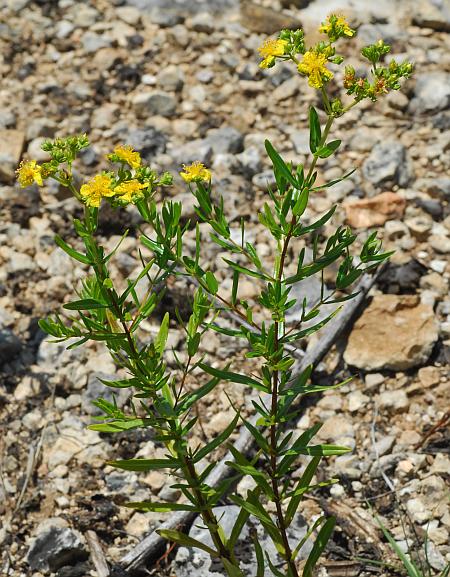Hypericum sphaerocarpum Michx.
Round-Fruited St. John's-Wort

Native
CC = 5
CW = 3
MOC = 74
© SRTurner
Hypericum sphaerocarpum Michx.Round-Fruited St. John's-Wort | |
 |
Native CC = 5 CW = 3 MOC = 74 |
© SRTurner |
|
Family - Hypericaceae Habit - Perennial forb, the rootstock and stem bases often somewhat woody, sometimes with short, poorly developed rhizomes Stem - Often multiple, ascending to erect, to 70 cm, angled or slightly ridged below each leaf, reddish brown, the surface often peeling in thin strips with age.
Leaves - Opposite, simple, entire, sessile. Blades 20-70 mm long, 3-15 mm wide, narrowly oblong or elliptic, rounded to bluntly pointed at the tip, tapered or narrowed at the base, the margins often rolled under at maturity, herbaceous to somewhat leathery in texture, with a single midvein, with 3 main veins sometimes visible toward the base, the surfaces lacking noticeable black dots, lines, or streaks but usually with minute, faint, pale to yellowish brown dots visible, the upper surface green, the undersurface pale green and sometimes somewhat glaucous.
Inflorescences - Appearing as panicles of 7-70 flowers, rounded to more or less flat-topped in outline.
Flowers - Actinomorphic. Sepals 5, all similar in size and shape, 2.5-5.0 mm long, not becoming enlarged at fruiting, lanceolate to broadly ovate, the margins occasionally slightly curled, lacking noticeable yellowish brown or black dots or streaks. Petals 5, 5-9 mm long, oblanceolate to elliptic, bright yellow, usually shed before fruiting. Stamens 45-85, the filaments not fused into groups. Ovary 1-locular or appearing partially 3-locular by intrusion of the parietal placentae into the locule. Styles 3, sometimes fused toward the base, erect and more or less appressed at flowering, persistent and usually separating somewhat as the fruit matures, the stigmas minute.
Fruits - Capsules 4.5-8.0 mm long, ovoid, widest at or slightly below the midpoint, tapered abruptly to the beak (this sometimes absent), circular in cross-section. Seeds 4-8 per capsule, 2.0-2.7 mm long, the surface with a coarse network of ridges and pits, dark brown to nearly black.
Flowering - May - September. Habitat - Glades, bluff tops, forest openings, fens, pond margins. Origin - Native to the U.S. Lookalikes - H. dolabriforme, which has not yet been found in Missouri but occurs immediately to our east in Kentucky and Illinois. More broadly, other members of the Hypericum genus. Other info. - This member of the St. John's wort genus is found mostly on calcareous glades, where it can be fairly abundant. It occurs across Missouri, with a U.S. distribution centered in the Midwest. Photographs taken at Danville Conservation Area, Montgomery County, MO, 6-27-2017, Shaw Nature Reserve, Franklin County, MO, 7-27-2019, and Bohigian Conservation Area, Phelps County, MO, 6-23-2023 (SRTurner). |